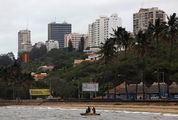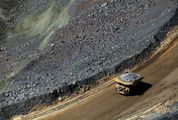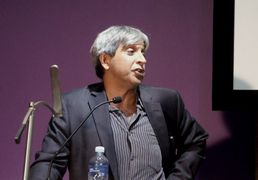THE threat to SA’s supply of clean water, now reaching alarming proportions, is largely of the country’s own making. Cycles of hot, dry weather are a regular climate phenomenon, yet the authorities do not learn from history and prepare in advance, critics say.
"For those who listen, the past always has a way of returning," says Prof Bhekisipho Twala, head of the department of electrical and electronic engineering science at the University of Johannesburg.
"We are in trouble not only because the weather is capricious, but because we are not prepared to deal with the inevitable. We never seem to learn that cycles are so called because they repeat themselves," he says.
Council for Scientific and Industrial Research spokeswoman Reyhana Mahomed says its researchers, the South African Weather Service and several universities are conducting research into the mechanisms and consequences of climate dynamics.
She said the research aimed to "develop the tools and improve the models" to more accurately understand and project climate and various atmospheric interactions.
Water and Sanitation Minister Nomvula Mokonyane said earlier this month that the bulk of SA’s economic nodes and national growth points were served by 238 water schemes and most of the systems had a positive water balance, with the national average dam storage at 66% of capacity.
...
THE drought gripping parts of the country affects 173 of the 1,628 water supply schemes, serving about 18% of the population.
Mokonyane says her department had monitored weather patterns and after hearing predictions of low rainfall this summer, took measures to alleviate them after completing a three-year outlook. In Gauteng, for example, water was released from Sterkfontein Dam to the Vaal Dam to create storage in the Sterkfontein Dam, which was filled with water pumped from the Tugela River.
Almost identical warnings about water scarcity being issued today were aired by management consultants McKinsey nearly six years ago.
"SA will face difficult economic and social choices between the demands for water for agriculture, key industrial activities such as mining and power generation, and large and growing urban centres," the 2010 report warned, saying that solutions were possible and did not need to be prohibitively expensive.
"Critically, it is clear the government and private sector must partner to develop effective policies and sustainable solutions," wrote Marc van Olst, a former partner in McKinsey’s Johannesburg office and one of the authors of the study, Confronting SA’s Water Challenge.
The solutions include technical improvements to increase clean water supply and conservation, along with improvements in productivity and efficiency.
Most water economists and analysts agree that if SA is ever to be ready to deal with cyclical droughts, it must act rapidly to implement a balanced solution for closing its demand-supply gap.
This can be achieved by applying a range of cost-effective supply measures such as agricultural efficiency and productivity improvements aggressively.
...
MCKINSEY’s experts believe that such outcomes can be led only by the government, and most effectively in partnership with the private sector. Most importantly, the failing water infrastructure must be upgraded and maintained.
The government is chiefly to blame for the current crisis through its lack of leadership, will and responsibility. It has allowed SA’s access to clean water to deteriorate. It spent good money to identify the problems and then did nothing about them.
"Simply expressed, we need to store more clean water, but the government is squeezed for money and skills to build new dams. This country also does not lend itself to too many more new big dam builds. It is nearing dam saturation, so to speak," says senior engineer Peter Townshend, consultant to WSP/Parsons Brinckerhoff and director of Amanzi Flow.
Townshend maintains that the water supply can be increased by 20% to 30% by upgrading dams. He advocates a multilayered repair and restructure programme.
"When dams are repaired or undergo major maintenance, they could be upgraded to increase storage capacity. This is easier and more convenient than it might sound," he says.
"Some dams could also be fitted with desedimentation systems to greatly improve capacity and operational performance."
...
TOWNSHEND points out that, of SA’s 5,120 registered dams, at least 1,000 in the medium to large category do not comply fully with dam-safety regulations — mainly due to inadequate spillway capacity, age, lack of skilled surveillance, maintenance and funding.
"There’s a possibility that SA could lose large dams in the event of a big flood. Most have a 50-year sell-by date. Some have already passed (this)," he warns.
One government solution to the water crisis is to import engineers from Cuba, a move Townshend does not believe is necessary. "We have an oversupply of engineers."
Townshend says raising the height of dam walls, for example, could add an additional 20%-25% capacity. "More attention should be given and more money spent on significantly increasing education around efficient water care."
"This includes its best use — recycling, rainwater harvesting and surplus water storage tanks should be basic features in reconstruction and development programmes and other affordable housing.
"Additionally, money must be expended on repairing and replacing aged piping and poorly maintained reticulation systems, where as much as 40% of water loss in municipal areas is occurring," Townshend says.
A major change in rainfall pattern is entrenching, with more rain falling in the eastern half of the country and less in the west. Eventually, water will have to be transferred from wetter to drier regions through a series of waterways, at a considerable cost.
Consideration has also been given to tapping into the Congo and Zambezi rivers to divert water to the south via river systems, canals and pipelines.
"This is currently too expensive and has political uncertainties to overcome, but it could become a reality through sheer necessity and fewer options," Townshend says.
Desalination projects are another possibility, but require massive amounts of funding and electricity consumption, "both of which are at a premium and will probably stay that way for many years to come"..
Free State dams such as Krugersdrift are reaching critically low levels and are unable to supply farms desperate for water. Hundreds of fish have washed up dead on their banks. Picture: JULIAN RADEMEYER
THE threat to SA’s supply of clean water, now reaching alarming proportions, is largely of the country’s own making. Cycles of hot, dry weather are a regular climate phenomenon, yet the authorities do not learn from history and prepare in advance, critics say.
"For those who listen, the past always has a way of returning," says Prof Bhekisipho Twala, head of the department of electrical and electronic engineering science at the University of Johannesburg.
"We are in trouble not only because the weather is capricious, but because we are not prepared to deal with the inevitable. We never seem to learn that cycles are so called because they repeat themselves," he says.
Council for Scientific and Industrial Research spokeswoman Reyhana Mahomed says its researchers, the South African Weather Service and several universities are conducting research into the mechanisms and consequences of climate dynamics.
She said the research aimed to "develop the tools and improve the models" to more accurately understand and project climate and various atmospheric interactions.
Water and Sanitation Minister Nomvula Mokonyane said earlier this month that the bulk of SA’s economic nodes and national growth points were served by 238 water schemes and most of the systems had a positive water balance, with the national average dam storage at 66% of capacity.
...
THE drought gripping parts of the country affects 173 of the 1,628 water supply schemes, serving about 18% of the population.
Mokonyane says her department had monitored weather patterns and after hearing predictions of low rainfall this summer, took measures to alleviate them after completing a three-year outlook. In Gauteng, for example, water was released from Sterkfontein Dam to the Vaal Dam to create storage in the Sterkfontein Dam, which was filled with water pumped from the Tugela River.
Almost identical warnings about water scarcity being issued today were aired by management consultants McKinsey nearly six years ago.
"SA will face difficult economic and social choices between the demands for water for agriculture, key industrial activities such as mining and power generation, and large and growing urban centres," the 2010 report warned, saying that solutions were possible and did not need to be prohibitively expensive.
"Critically, it is clear the government and private sector must partner to develop effective policies and sustainable solutions," wrote Marc van Olst, a former partner in McKinsey’s Johannesburg office and one of the authors of the study, Confronting SA’s Water Challenge.
The solutions include technical improvements to increase clean water supply and conservation, along with improvements in productivity and efficiency.
Most water economists and analysts agree that if SA is ever to be ready to deal with cyclical droughts, it must act rapidly to implement a balanced solution for closing its demand-supply gap.
This can be achieved by applying a range of cost-effective supply measures such as agricultural efficiency and productivity improvements aggressively.
...
MCKINSEY’s experts believe that such outcomes can be led only by the government, and most effectively in partnership with the private sector. Most importantly, the failing water infrastructure must be upgraded and maintained.
The government is chiefly to blame for the current crisis through its lack of leadership, will and responsibility. It has allowed SA’s access to clean water to deteriorate. It spent good money to identify the problems and then did nothing about them.
"Simply expressed, we need to store more clean water, but the government is squeezed for money and skills to build new dams. This country also does not lend itself to too many more new big dam builds. It is nearing dam saturation, so to speak," says senior engineer Peter Townshend, consultant to WSP/Parsons Brinckerhoff and director of Amanzi Flow.
Townshend maintains that the water supply can be increased by 20% to 30% by upgrading dams. He advocates a multilayered repair and restructure programme.
"When dams are repaired or undergo major maintenance, they could be upgraded to increase storage capacity. This is easier and more convenient than it might sound," he says.
"Some dams could also be fitted with desedimentation systems to greatly improve capacity and operational performance."
...
TOWNSHEND points out that, of SA’s 5,120 registered dams, at least 1,000 in the medium to large category do not comply fully with dam-safety regulations — mainly due to inadequate spillway capacity, age, lack of skilled surveillance, maintenance and funding.
"There’s a possibility that SA could lose large dams in the event of a big flood. Most have a 50-year sell-by date. Some have already passed (this)," he warns.
One government solution to the water crisis is to import engineers from Cuba, a move Townshend does not believe is necessary. "We have an oversupply of engineers."
Townshend says raising the height of dam walls, for example, could add an additional 20%-25% capacity. "More attention should be given and more money spent on significantly increasing education around efficient water care."
"This includes its best use — recycling, rainwater harvesting and surplus water storage tanks should be basic features in reconstruction and development programmes and other affordable housing.
"Additionally, money must be expended on repairing and replacing aged piping and poorly maintained reticulation systems, where as much as 40% of water loss in municipal areas is occurring," Townshend says.
A major change in rainfall pattern is entrenching, with more rain falling in the eastern half of the country and less in the west. Eventually, water will have to be transferred from wetter to drier regions through a series of waterways, at a considerable cost.
Consideration has also been given to tapping into the Congo and Zambezi rivers to divert water to the south via river systems, canals and pipelines.
"This is currently too expensive and has political uncertainties to overcome, but it could become a reality through sheer necessity and fewer options," Townshend says.
Desalination projects are another possibility, but require massive amounts of funding and electricity consumption, "both of which are at a premium and will probably stay that way for many years to come"..
























Change: 1.37%
Change: 1.32%
Change: 2.91%
Change: 0.45%
Change: 3.09%
Data supplied by Profile Data
Change: 1.63%
Change: 0.83%
Change: 1.37%
Change: 0.00%
Change: 0.69%
Data supplied by Profile Data
Change: -2.04%
Change: -1.88%
Change: -1.66%
Change: -1.94%
Change: -1.37%
Data supplied by Profile Data
Change: -1.25%
Change: 0.00%
Change: -0.85%
Change: -1.74%
Change: 2.92%
Data supplied by Profile Data